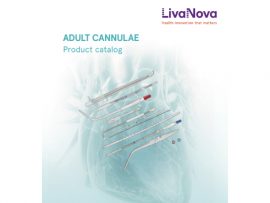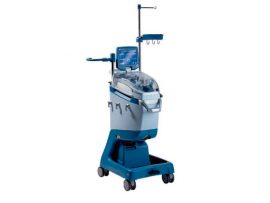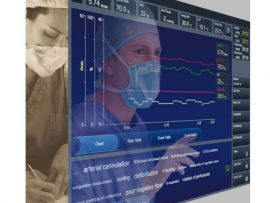Abstract Abstract Objectives: To investigate whether severe hyperoxia predisposes to end-organ complications and whether these complications contribute to in-hospital mortality among cardiogenic shock (CS) patients supported in veno-arterial extracorporeal membrane..
WeiterlesenAbstract Cardiogenic shock (CS) is a state of critical end-organ hypoperfusion caused by primary cardiac failure, in which the heart cannot generate sufficient output despite adequate preload and is associated..
WeiterlesenAbstract Rigorous research in cardiovascular physiology and medicine has led to critical advancements in preventing, diagnosing, and treating cardiovascular disease; however, striking disparities persist in cardiovascular disease prevention, diagnosis, and..
WeiterlesenAbstract Background Children undergoing cardiopulmonary bypass (CPB) surgery are vulnerable to bleeding and often require transfusions. Pathogen-reduced (PR) platelets may reduce microbial contamination but are associated with decreased platelet count..
WeiterlesenAbstract Background Effective securement of extracorporeal membrane oxygenation (ECMO) cannulae, both at the insertion site and along the length of circuit tubing, may reduce the risk of cannula migration, dislodgement,..
WeiterlesenAbstract Veno-arterial extracorporeal membrane oxygenation (V‑A ECMO) is a critical care therapy for patients with severe cardiorespiratory failure, and it is associated with high in‑hospital mortality rates. Causes are the..
WeiterlesenVenoarterial extracorporeal membrane oxygenation (VA ECMO) provides temporary mechanical circulatory support for patients in refractory cardiogenic shock. Initiation of VA ECMO often results in increased left ventricular (LV) afterload as..
WeiterlesenSpecial 3 day Rescue Team Course Paris NEXT SESSION 1 to 3 December for 2025 . Come learn all you need to know on OHCA, ECPR and REBOA during a..
Weiterlesen1. Introduction Cardiopulmonary bypass (CPB) leads to pronounced hemodilution and provokes a systemic inflammatory response from blood interaction with artificial surfaces (Ziyaeifard et al., 2014) (, ). Ultrafiltration (UF) mitigates these effects..
WeiterlesenIntroduction Hemophilia is a hereditary bleeding disorder caused by deficiency of clotting factor VIII (Hemophilia A) or factor IX (Hemophilia B), resulting in impaired blood coagulation and a heightened risk..
WeiterlesenAbstract Background: To investigate the factors that influence blood transfusions after neonatal cardiac surgery and their association with prolonged mechanical ventilation (PMV) to provide a basis for optimizing blood transfusion..
WeiterlesenAbstract Studies into the mechanisms of cardiopulmonary bypass-associated acute lung injury have not presented breakthroughs for many years, resulting in the stagnation of management strategies and clinical medicine measures. This..
WeiterlesenAbstract Postoperative organ dysfunction remains a major challenge in adult cardiac surgery with cardiopulmonary bypass (CPB), frequently involving the kidneys, heart, and lungs. These complications are primarily driven by hemolysis,..
WeiterlesenAbstract Background Veno-arterial extracorporeal membrane oxygenation (VA-ECMO) use for cardiogenic shock (CS) is increasing worldwide despite conflicting results from randomized trials, which focused on myocardial-infarction related CS (MI-CS). Methods We..
WeiterlesenAbstract The emergence of large language models (LLMs) opens new horizons to leverage, often unused, information in clinical text. Our study aims to capitalise on this new potential. Specifically, we..
WeiterlesenAbstract Background Cardioplegic arrest can be induced by various methods, fueling a long-standing controversy about their comparative merit. We aim to compare cardioplegic methods in coronary artery disease. Methods PubMed,..
WeiterlesenAbstract Normothermic regional perfusion (NRP) is a strategy of postmortem reperfusion with warm oxygenated blood of a portion of the body applied in donors undergoing circulatory determination of death (DCDDs)...
WeiterlesenAbstract Perioperative impairment of glycaemic control significantly increases the risk of major postoperative complications. The use of continuous glucose monitoring (CGM) has demonstrated benefits in glycaemic control, but its use..
WeiterlesenAbstract The common carotid artery (CCA) is an easily accessible means of providing cerebral and systemic perfusion during complex aortic surgery. Our technique for using CCA perfusion through a graft..
WeiterlesenAbstract Background The optimal low‐flow duration (LFD) for extracorporeal cardiopulmonary resuscitation (ECPR) and conventional cardiopulmonary resuscitation (CCPR) remains unclear. We evaluated the impact of LFD on neurological outcomes based on..
WeiterlesenAbstract Objectives Our aim was to assess the association between mixed venous oxygen saturation (SvO2) and cardiac index (CI) among cardiac surgical patients during the initial 4 hours in the..
WeiterlesenAbstract Background Acute kidney injury (AKI) is a frequent and severe complication following cardiac surgery, particularly in patients with impaired kidney function. The existing Kidney Disease: Improving Global Outcomes (KDIGO)..
WeiterlesenAbstract Objectives To identify independent predictors of 30-day mortality, adverse discharge, and length of hospital stay following a perioperative stroke among cardiac surgical patients, and to measure trends in outcomes..
WeiterlesenAbstract Introduction Cardiac surgery remains a high-risk procedure for bleeding despite advances in patient blood management. Conventional centrifugation-based autotransfusion devices primarily recover red blood cells, losing platelets and coagulation factors. The..
WeiterlesenAbstract Mesenteric ischemia (Me-Is) is a severe complication with high mortality after cardiac surgery. We examined whether intestinal fatty acid binding protein (I-FABP) might serve as a biomarker for early..
WeiterlesenAbstract Objective: To identify risk factors for bleeding and thrombotic complications during extracorporeal membrane oxygenation (ECMO) support in adults and to develop a predictive model based on these factors...
WeiterlesenAbstract We read with great interest the article by Kowara et al.,[] which highlights the potential of PvCO2 × Ve/Q as a key predictive marker for hyperlactatemia during cardiopulmonary bypass (CPB). This..
Weiterlesen






















